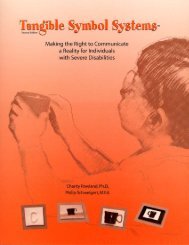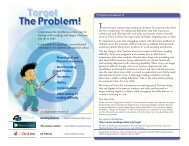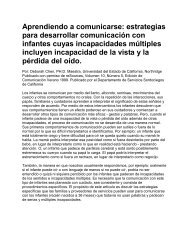ACCOMMODATIONS MANUAL - The Office of Special Education ...
ACCOMMODATIONS MANUAL - The Office of Special Education ...
ACCOMMODATIONS MANUAL - The Office of Special Education ...
Create successful ePaper yourself
Turn your PDF publications into a flip-book with our unique Google optimized e-Paper software.
STEP 2<br />
LEARN ABOUT <strong>ACCOMMODATIONS</strong> FOR INSTRUCTION AND<br />
ASSESSMENT<br />
WHAT ARE <strong>ACCOMMODATIONS</strong>?<br />
Accommodations are practices and procedures in the areas <strong>of</strong> presentation, response, setting, and<br />
timing/scheduling that provide equitable access during instruction and assessments for students<br />
with disabilities.<br />
Accommodations are intended to reduce or even eliminate the effects <strong>of</strong> a student’s disability;<br />
they do not reduce learning expectations. <strong>The</strong> accommodations provided to a student must be the<br />
same for classroom instruction, classroom assessments, and district and state assessments. It is<br />
critical to note that although some accommodations may be appropriate for instructional use,<br />
they may not be appropriate for use on a standardized assessment. <strong>The</strong>re may be consequences<br />
(e.g., lowering or not counting a student’s test score) for the use <strong>of</strong> some accommodations during<br />
state assessments. It is very important for educators to become familiar with state policies<br />
regarding accommodations during assessments.<br />
Typically, accommodation use does not begin and end in school. Students who use<br />
accommodations will generally also need them at home, in the community, and as they get older,<br />
in postsecondary education and at work. Accommodations for instruction and assessment are<br />
integrally intertwined.<br />
DESCRIPTION OF <strong>ACCOMMODATIONS</strong> CATEGORIES<br />
Accommodations are commonly categorized in four ways: presentation, response, setting, and<br />
timing and scheduling:<br />
• Presentation Accommodations—Allow students to access information in<br />
ways that do not require them to visually read standard print. <strong>The</strong>se alternate<br />
modes <strong>of</strong> access are auditory, multi-sensory, tactile, and visual.<br />
• Response Accommodations—Allow students to complete activities,<br />
assignments, and assessments in different ways or to solve or organize<br />
problems using some type <strong>of</strong> assistive device or organizer.<br />
• Setting Accommodations—Change the location in which a test or<br />
assignment is given or the conditions <strong>of</strong> the assessment setting.<br />
• Timing and Scheduling Accommodations—Increase the allowable length <strong>of</strong><br />
time to complete an assessment or assignment and perhaps change the way the<br />
time is organized.<br />
Refer to Fact Sheets 1-4 for specific examples <strong>of</strong> accommodations in these categories.<br />
14





